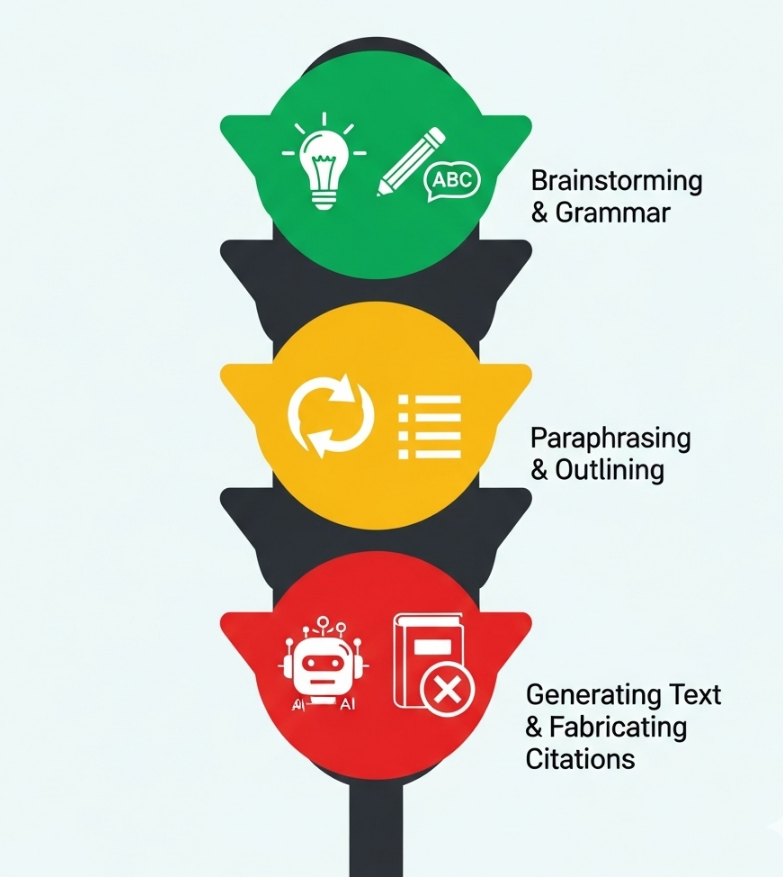AI writing tools like ChatGPT and Google
Gemini have exploded into the mainstream, offering powerful assistance for
everything from drafting an email to writing code. For students and
researchers, these tools present a tantalizing opportunity to streamline the
writing process. But they also introduce a minefield of ethical questions.
Where is the boundary between using AI as a
helpful assistant and committing academic misconduct? Can you use ChatGPT to
polish your language? Can it write your literature review?

Green Light: Safe and Encouraged Uses of
AI Tools
Think of AI in this category as a
sophisticated grammar checker or an interactive thesaurus. These uses help
improve the quality of your writing without compromising the integrity
of your ideas.
- Improving Language and Clarity: For
non-native English speakers, AI is an invaluable tool for correcting
grammar, improving sentence structure, and finding more precise
vocabulary. Using it to make your writing clearer and more professional is
widely accepted.
- Brainstorming and Idea Generation:
AI can be a great sounding board. You can use it to explore potential
research questions, generate keywords for a literature search, or get
different perspectives on a topic to overcome writer's block.
- Summarizing Complex Papers (for Understanding): Pasting the abstract or a section of a dense academic paper
into an AI tool and asking for a simplified summary can be a useful way to
aid your own understanding of complex topics.
- Formatting Assistance: You can ask
an AI tool to format your bibliography into a specific style (e.g., APA,
MLA), but you must always double-check the output for accuracy.
Yellow Light: Use with Extreme Caution
and Full Transparency
This is the grey area. Using AI for these
tasks is not strictly forbidden by all, but it requires careful human
oversight, significant editing, and, in most cases, disclosure to the journal
or instructor.
- Paraphrasing: While you can use AI
to rephrase a sentence, you are walking a fine line. AI can sometimes
paraphrase too closely to the original source or misinterpret the nuance,
leading to unintentional plagiarism. The final paraphrased text must be
your own work, accurately representing the source and properly cited.
- Creating an Initial Outline or Draft: Asking an AI to generate a structural outline for your paper
is acceptable. However, using it to write the first draft of entire
paragraphs is risky. The core arguments, logic, and synthesis of ideas
must come from you. An AI-generated draft can lack the critical thinking
and novel insights required for academic work.
- Literature Search: You can ask an
AI for key papers in a field, but you must be incredibly careful. AI
models are known to "hallucinate"—that is, invent
realistic-sounding but completely non-existent sources and citations.
Every source suggested by an AI must be manually verified.
Red Light: Unacceptable and Unethical
Uses (Academic Misconduct)
Crossing these lines is equivalent to
plagiarism, fabrication, or other forms of academic dishonesty.
- Generating Entire Sections of Text:
Copying and pasting AI-generated text for your introduction, methods,
results, or discussion sections and presenting it as your own is a serious
form of plagiarism.
- Fabricating Data or References:
Using an AI to generate data or citing sources "hallucinated" by
an AI is a form of data fabrication and is a severe breach of research
ethics.
- Listing AI as a Co-author: Major
academic publishers (including Nature, Science, and IEEE)
have explicitly forbidden listing AI tools as authors. Authorship is
reserved for humans who can take responsibility for the work's integrity.
- Writing Peer Review Reports: Using
AI to write a review of another author's work is unethical, as it
outsources the critical, human judgment that the peer review process
relies upon.
The Golden Rule: Disclosure, Disclosure,
Disclosure
If you have used an AI tool for anything
more than basic grammar correction, the emerging consensus is that you must
disclose it. Many journals now require an "AI in Writing" or similar
section in the manuscript, where you must specify which tool you used and for
what purpose. Transparency is your best defense against accusations of
misconduct.
The Bottom Line: AI is a Tool, Not a
Thinker
Before using any AI writing tool, always
check the specific policies of your university and the journal you are
submitting to.
Treat AI as a powerful but imperfect
assistant. It can help you polish your language, organize your thoughts, and
check your grammar. It cannot, however, replace the most critical elements of
academic work: your original ideas, your critical analysis, and your
intellectual integrity.


